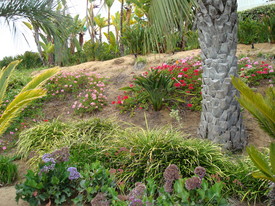 Gardens are imagination. We design what we want it to look like and then we toil in the dirt to make it happen.
Gardens are imagination. We design what we want it to look like and then we toil in the dirt to make it happen.
But these days there are many changes in how we think about our garden. About its design. About maintenance and the time it takes. And about ecology.
The designs now in style are the "Back to Nature" or "Ecological" types. They use more shades of green, fewer flowers and native plants. and maybe try to look like an imagined meadow or a forest or a mountaintop field of wild flowers.
Going out of style is classic garden design, with its geometric shapes and pruned shrubs. (Think Roman, Renaissance, Versailles, English and Colonial) Still evolving is the English naturalistic style, an idealized meadow and forest with a carefully planned succession of bloom. (Think Capability Brown, Olmsted, Boston’s Emerald Necklace). The problem with the old design styles is they require high maintenance. Meanwhile our society is going through a significant upheaval in how and where we use our time.
We may think that ecological designs will do away with maintenance time and that old Ma Nature will take care of it. But the word "ecological" is complex and often misunderstood. I borrow here from a paper by Peter Del Tredici of the Arnold Arboretum in Boston.
He says, " Nature abhors a garden." Unmanaged "natural" landscapes (like fields, forests and bogs) lead to an unpredictable succession of plant communities which constantly change and evolve. In ecological systems, "stability is an illusion." It’s survival of the fittest.
However gardens and designed landscapes are meant to be stable. The plants are in fixed positions (even if it looks rustic). Gardening is essentially about humans controlling the successional process.
If we don’t maintain our gardens, the ravages of weather, weeds, pests and diseases will turn it into something we never imagined. Invasive weeds, shrubs and trees will take control, be they native (like poison ivy) or foreign invasives (like Norway maples), And it reverts to the survival of the fittest again.
In the wild, as well as on conservation land, humans have to control the plant succession or it too becomes survival of the fittest. Meadows need mowing to control undesired puckerbush and a return to scrub forest. Older forests, especially near population centers, need to be kept clear of dead wood and fire brush/tinder or they will easily burn.
The new "Green Landscaping" is changing our design thinking, and some folks may think it may be a little easier to maintain, but don’t kid yourself, it’s still a designed garden, not Mother Nature’s survival of the fittest.
So here’s a maintenance tip for August and ecological, of course. For perennial gardens, in the North, the end of August is the best time to transplant and divide spring and summer blooming perennials. In the warm September soil, they’ll grow new roots, set flower buds (if the plants are big enough) and store nutrients for next year.
Each plant has its own particular preferences of how to divide and prune. Lots of info is on the web. Ditto, it’s the best time to apply grass seed. If you are real quick, you can plant a fall crop of some vegetables (kale, leaf lettuce, beets, carrots, Swiss chard, spinach).
Gardens are still our imagination. We toil for tomorrow’s harvest.
Ruth S. Foster is a landscape consultant and arborist. More gardening
information can be found on her website: www.mothersgarden.net.
Credit: mothersgarden.net




























